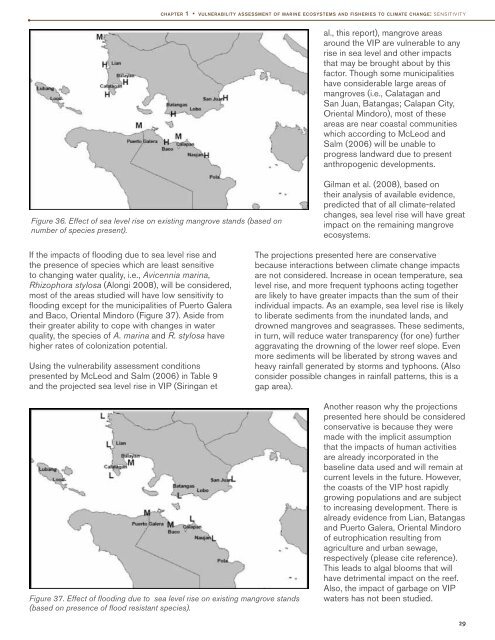of the Verde Island Passage, Philippines - weADAPT
of the Verde Island Passage, Philippines - weADAPT
of the Verde Island Passage, Philippines - weADAPT
You also want an ePaper? Increase the reach of your titles
YUMPU automatically turns print PDFs into web optimized ePapers that Google loves.
chapter 1 • vulnerability assessment <strong>of</strong> marine ecosystems and fisheries to climate change: sensitivity<br />
al., this report), mangrove areas<br />
around <strong>the</strong> VIP are vulnerable to any<br />
rise in sea level and o<strong>the</strong>r impacts<br />
that may be brought about by this<br />
factor. Though some municipalities<br />
have considerable large areas <strong>of</strong><br />
mangroves (i.e., Calatagan and<br />
San Juan, Batangas; Calapan City,<br />
Oriental Mindoro), most <strong>of</strong> <strong>the</strong>se<br />
areas are near coastal communities<br />
which according to McLeod and<br />
Salm (2006) will be unable to<br />
progress landward due to present<br />
anthropogenic developments.<br />
Figure 36. Effect <strong>of</strong> sea level rise on existing mangrove stands (based on<br />
number <strong>of</strong> species present).<br />
Gilman et al. (2008), based on<br />
<strong>the</strong>ir analysis <strong>of</strong> available evidence,<br />
predicted that <strong>of</strong> all climate-related<br />
changes, sea level rise will have great<br />
impact on <strong>the</strong> remaining mangrove<br />
ecosystems.<br />
If <strong>the</strong> impacts <strong>of</strong> flooding due to sea level rise and<br />
<strong>the</strong> presence <strong>of</strong> species which are least sensitive<br />
to changing water quality, i.e., Avicennia marina,<br />
Rhizophora stylosa (Alongi 2008), will be considered,<br />
most <strong>of</strong> <strong>the</strong> areas studied will have low sensitivity to<br />
flooding except for <strong>the</strong> municipalities <strong>of</strong> Puerto Galera<br />
and Baco, Oriental Mindoro (Figure 37). Aside from<br />
<strong>the</strong>ir greater ability to cope with changes in water<br />
quality, <strong>the</strong> species <strong>of</strong> A. marina and R. stylosa have<br />
higher rates <strong>of</strong> colonization potential.<br />
Using <strong>the</strong> vulnerability assessment conditions<br />
presented by McLeod and Salm (2006) in Table 9<br />
and <strong>the</strong> projected sea level rise in VIP (Siringan et<br />
The projections presented here are conservative<br />
because interactions between climate change impacts<br />
are not considered. Increase in ocean temperature, sea<br />
level rise, and more frequent typhoons acting toge<strong>the</strong>r<br />
are likely to have greater impacts than <strong>the</strong> sum <strong>of</strong> <strong>the</strong>ir<br />
individual impacts. As an example, sea level rise is likely<br />
to liberate sediments from <strong>the</strong> inundated lands, and<br />
drowned mangroves and seagrasses. These sediments,<br />
in turn, will reduce water transparency (for one) fur<strong>the</strong>r<br />
aggravating <strong>the</strong> drowning <strong>of</strong> <strong>the</strong> lower reef slope. Even<br />
more sediments will be liberated by strong waves and<br />
heavy rainfall generated by storms and typhoons. (Also<br />
consider possible changes in rainfall patterns, this is a<br />
gap area).<br />
Figure 37. Effect <strong>of</strong> flooding due to sea level rise on existing mangrove stands<br />
(based on presence <strong>of</strong> flood resistant species).<br />
Ano<strong>the</strong>r reason why <strong>the</strong> projections<br />
presented here should be considered<br />
conservative is because <strong>the</strong>y were<br />
made with <strong>the</strong> implicit assumption<br />
that <strong>the</strong> impacts <strong>of</strong> human activities<br />
are already incorporated in <strong>the</strong><br />
baseline data used and will remain at<br />
current levels in <strong>the</strong> future. However,<br />
<strong>the</strong> coasts <strong>of</strong> <strong>the</strong> VIP host rapidly<br />
growing populations and are subject<br />
to increasing development. There is<br />
already evidence from Lian, Batangas<br />
and Puerto Galera, Oriental Mindoro<br />
<strong>of</strong> eutrophication resulting from<br />
agriculture and urban sewage,<br />
respectively (please cite reference).<br />
This leads to algal blooms that will<br />
have detrimental impact on <strong>the</strong> reef.<br />
Also, <strong>the</strong> impact <strong>of</strong> garbage on VIP<br />
waters has not been studied.<br />
29
















